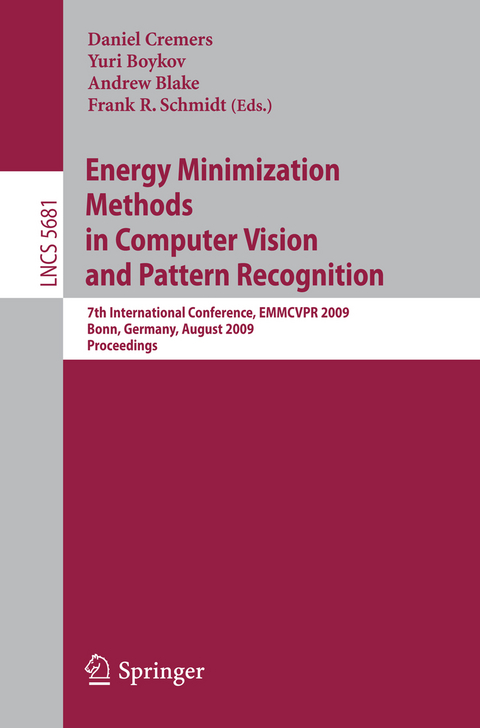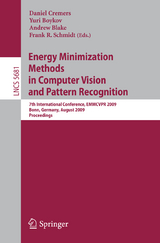Energy Minimization Methods in Computer Vision and Pattern Recognition
Springer Berlin (Verlag)
978-3-642-03640-8 (ISBN)
Discrete Optimization and Markov Random Fields.- Multi-label Moves for MRFs with Truncated Convex Priors.- Detection and Segmentation of Independently Moving Objects from Dense Scene Flow.- Efficient Global Minimization for the Multiphase Chan-Vese Model of Image Segmentation.- Bipartite Graph Matching Computation on GPU.- Pose-Invariant Face Matching Using MRF Energy Minimization Framework.- Parallel Hidden Hierarchical Fields for Multi-scale Reconstruction.- General Search Algorithms for Energy Minimization Problems.- Partial Differential Equations.- Complex Diffusion on Scalar and Vector Valued Image Graphs.- A PDE Approach to Coupled Super-Resolution with Non-parametric Motion.- On a Decomposition Model for Optical Flow.- A Schrödinger Wave Equation Approach to the Eikonal Equation: Application to Image Analysis.- Computing the Local Continuity Order of Optical Flow Using Fractional Variational Method.- A Local Normal-Based Region Term for Active Contours.- Segmentation and Tracking.- Hierarchical Pairwise Segmentation Using Dominant Sets and Anisotropic Diffusion Kernels.- Tracking as Segmentation of Spatial-Temporal Volumes by Anisotropic Weighted TV.- Complementary Optic Flow.- Parameter Estimation for Marked Point Processes. Application to Object Extraction from Remote Sensing Images.- Three Dimensional Monocular Human Motion Analysis in End-Effector Space.- Robust Segmentation by Cutting across a Stack of Gamma Transformed Images.- Shape Optimization and Registration.- Integrating the Normal Field of a Surface in the Presence of Discontinuities.- Intrinsic Second-Order Geometric Optimization for Robust Point Set Registration without Correspondence.- Geodesics in Shape Space via Variational Time Discretization.- Image Registration under Varying Illumination:Hyper-Demons Algorithm.- Hierarchical Vibrations: A Structural Decomposition Approach for Image Analysis.- Inpainting and Image Denoising.- Exemplar-Based Interpolation of Sparsely Sampled Images.- A Variational Framework for Non-local Image Inpainting.- Image Filtering Driven by Level Curves.- Color Image Restoration Using Nonlocal Mumford-Shah Regularizers.- Reconstructing Optical Flow Fields by Motion Inpainting.- Color and Texture.- Color Image Segmentation in a Quaternion Framework.- Quaternion-Based Color Image Smoothing Using a Spatially Varying Kernel.- Locally Parallel Textures Modeling with Adapted Hilbert Spaces.- Global Optimal Multiple Object Detection Using the Fusion of Shape and Color Information.- Statistics and Learning.- Human Age Estimation by Metric Learning for Regression Problems.- Clustering-Based Construction of Hidden Markov Models for Generative Kernels.- Boundaries as Contours of Optimal Appearance and Area of Support.
| Erscheint lt. Verlag | 11.8.2009 |
|---|---|
| Reihe/Serie | Image Processing, Computer Vision, Pattern Recognition, and Graphics | Lecture Notes in Computer Science |
| Zusatzinfo | X, 494 p. |
| Verlagsort | Berlin |
| Sprache | englisch |
| Maße | 155 x 235 mm |
| Gewicht | 760 g |
| Themenwelt | Informatik ► Grafik / Design ► Digitale Bildverarbeitung |
| Informatik ► Theorie / Studium ► Künstliche Intelligenz / Robotik | |
| Schlagworte | Algorithm analysis and problem complexity • computer vision • Energy Minimization • GPU computing • graph theory • Hardcover, Softcover / Informatik, EDV/Informatik • Image Analysis • image denoising • Image Registration • image restauration • Image Segmentation • multi-scale • optical flow • Optimization • Pattern Matching • pattern recognition • Remote Sensing • wireless networks |
| ISBN-10 | 3-642-03640-6 / 3642036406 |
| ISBN-13 | 978-3-642-03640-8 / 9783642036408 |
| Zustand | Neuware |
| Informationen gemäß Produktsicherheitsverordnung (GPSR) | |
| Haben Sie eine Frage zum Produkt? |
aus dem Bereich




